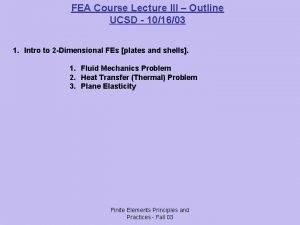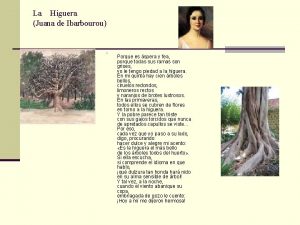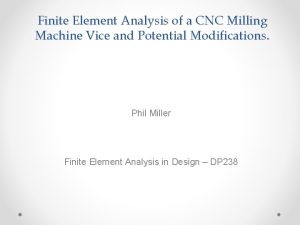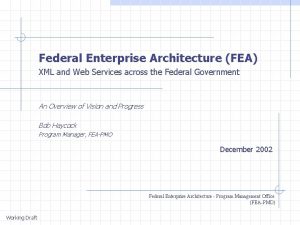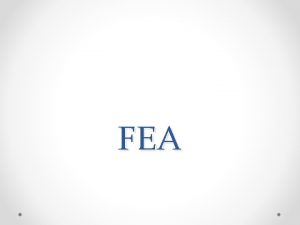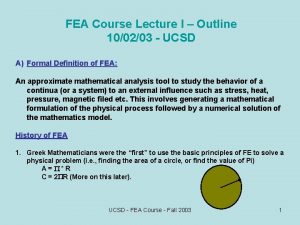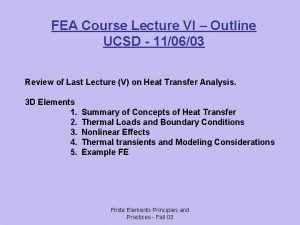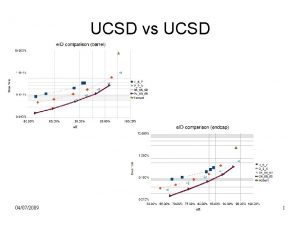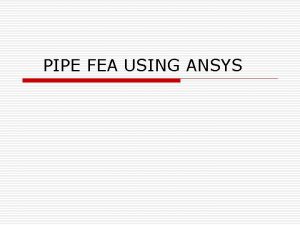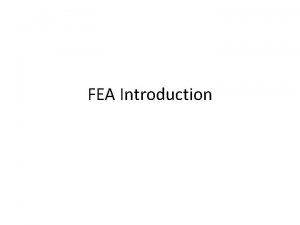FEA Course Lecture III Outline UCSD 101603 1









- Slides: 9

FEA Course Lecture III – Outline UCSD - 10/16/03 1. Intro to 2 -Dimensional FEs [plates and shells]. 1. Fluid Mechanics Problem 2. Heat Transfer (Thermal) Problem 3. Plane Elasticity Finite Elements Principles and Practices - Fall 03

2 -Dimensional Finite Elements 1. Stiffness and Load Vector Formulations for mechanical, heat transfer and fluid flow problems. The system equation to be solved can be written in matrix form as: [K] {D} = {q} Where [K] is traditional known as the ‘stiffness’ or ‘coefficient’ matrix (conductance matrix for heat transfer, flow-resistance matrix for fluid flow), {D} is the displacement (or temperature, or velocity) vector and {q} is the force (or thermal load, or pressure gradient) vector. Finite Elements Principles and Practices - Fall 03

C) For plane elasticity problem in 2 -dimensional, we have: 1. Plane Problems – are also known as Plane Elasticity Problems 2. Plane – a flat element with constant thickness 3. There are two types of plane problems • Plane Stress – thickness of the third dimension of an elastic body is very small. Sigma_XZ = Sigma_YZ = Sigma_ZZ = 0 • Plane Strain - thickness of the third dimension of an elastic body is infinitely large. t=infinity Finite Elements Principles and Practices - Fall 03

Governing Differential Equation: Stress-Strain Relationships s=Ee Strain Plane Stress C 11 = C 22 = E/(1 -n 2) C 12 = n. E/(1 -n 2) C 66 = (1 -n)E/2(1 -n 2) Finite Elements Principles and Practices - Fall 03 Plane C 11 = C 22 = (1 -n)E/(1+n)/(1 -2 n) C 12 = n. E/(1+n)/(1 -n) C 66 = (1 -2 n)E/2/(1+n)/(1 -2 n)

1. Types of Finite Elements used in Plane Elasticity a) CST – Constant Strain Triangle b) LST – Linear Strain Triangle (Quadratic Triangle) c) Q 4 – Bilinear Quadrilateral Finite Elements Principles and Practices - Fall 03

d) Q 8 – Quadratic Quadrilateral e) Q 6 –Improved Bilinear Quadrilateral f) Elements with Drilling DOF (Degree of Freedom) When using beams and shell elements (say stiffeners) Folded Plates and Shells Finite Elements Principles and Practices - Fall 03

A) For heat transfer problem in 2 -dimensional, we have: Finite Elements Principles and Practices - Fall 03

B) For fluid flow problem in 2 -dimensional, we have: Finite Elements Principles and Practices - Fall 03

Review of Analysis Results. E. g. , Plane Elasticity. Exact Vs FE solution. Error Estimation. SOFTWARE-Specific Session: Build 2 D problem on ANSYS. Go through all steps. Thermal problem on ANSYS Plane-stress problem on ANSYS 2 DFlow problem on ANSYS/FEMLAB. Homework 2 and Reading Assignments. Finite Elements Principles and Practices - Fall 03
